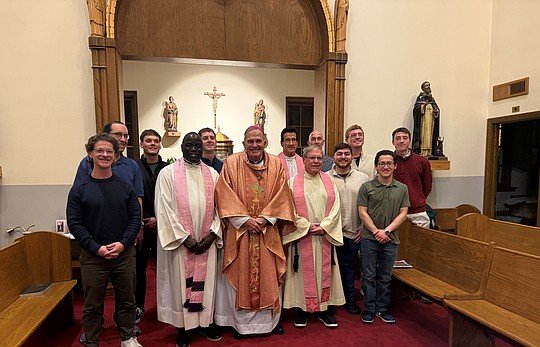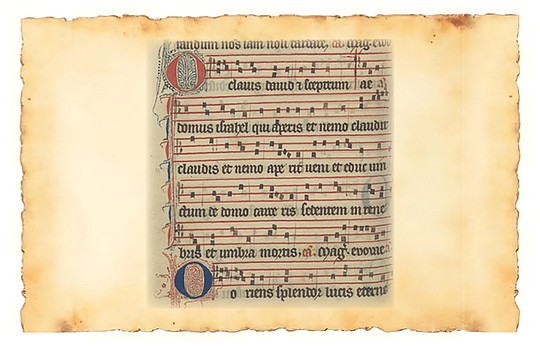Vocation to consecrated life remains vitally important to Church
January 31, 2025 at 3:40 p.m.

A message from Bishop David M. O’Connell, C.M., for World Day of Prayer for Consecrated Life, Feb. 2, 2025.
People will occasionally ask me what the letters “CM” mean after my name. As a member of a religious community in the Church, I am identified as belonging to that religious community by its initials. “CM” designates membership in the Congregation of the Mission, more popularly known as “the Vincentians.”
We are a Society of Apostolic Life founded by St. Vincent de Paul in Paris, France, over 400 years ago. Our charism is to find and serve Christ present in the poor by preaching the Gospel to them.
We were also founded to train and assist the diocesan clergy, of which St. Vincent de Paul was a member in the Diocese of Paris. As Vincentians, we profess the evangelical counsels or “vows” of poverty, chastity, obedience and stability in the Congregation. When consecrated a bishop, however, the vows of poverty, obedience and stability are dispensed since, as bishop, the religious priest becomes a member of the diocese he oversees while still “belonging to the order.”
The bishop’s obedience shifts from his religious superior to the Pope alone and, like other diocesan priests, his vow of poverty is translated to a commitment to simplicity of life since, rather than his community, he becomes responsible for his own support.
I mention these things because the Church in the parishes of every diocese recognizes and celebrates World Day of Prayer for Consecrated Life, this year on Feb. 2. Established by Pope St. John Paul II in 1997, this special commemoration honors the legions of women and men who, prompted by the Holy Spirit, have and continue to respond to the Lord’s call to “follow him” in religious or “consecrated” life through vowed commitments of poverty, chastity and obedience after the example of the founders of their religious orders, institutes, societies and congregations.
Here in the United States, throughout its history, the Catholic Church has depended upon these consecrated women and men for so many of the essential ministries that have enabled the Catholic Church to grow, flourish and thrive. They are the Franciscan and Jesuit missionaries who labored in Colonial times, as well as the countless numbers of dedicated religious women who built and taught in Catholic schools, served in hospitals, reached out to comfort and serve the poor through social services and parish ministry or devoted themselves to prayer in a cloister. They include the many who have faithfully served in our own Diocese: the Religious Teachers Filippini, the Sisters of St. Joseph, the Sisters of Mercy, the Sister Servants of the Immaculate Heart of Mary, the Sisters of St. Francis, the Missionaries of Charity, the Resurrection Sisters, the Poor Clares, and many others.
Other religious communities that have served in this Diocese include the Christian Brothers at Christian Brothers Academy in Lincroft, the Trinitarians, the Conventual Franciscans, the Franciscan Order of Friars Minor, the Society of the Divine Word, the Vincentians, the Consolata Missionaries, the Dominicans, the Redemptorists, the Oratory of St. Philip Neri and so many others.
It is virtually impossible to imagine the history of Diocese of Trenton without the presence of so many extraordinary women and men in consecrated life who, with the diocesan clergy, have been the inspiration and motivation for what the Catholic Church has meant for and accomplished in the local Church and the lives of the faithful here.
While it is true that their numbers have diminished significantly in recent decades, the incredible witness of the vocation to consecrated life is still vitally important to the Catholic Church. God continues to call women and men to follow him in the religious orders, institutes, associations of the faithful, societies and congregations whose charisms and missions build his Kingdom here on earth.
When he established World Day of Prayer for Consecrated Life 26 years ago, Pope St. John Paul II chose the Feast of the Presentation – when candles are blessed in the world’s churches (Candlemas Day) – as the day for its celebration since that was the occasion in the second chapter of the Gospel of St. Luke when the Blessed Mother and St. Joseph presented the Lord Jesus to God in the temple as “a light of revelation to the Gentiles and the glory of your people, Israel (Luke 2:32).”
The Holy Father wrote, “…the Presentation of Jesus in the Temple is an eloquent icon of the total offering of one's life for all those who are called to show forth in the Church and in the world, by means of the evangelical counsels "the characteristic features of Jesus -- the chaste, poor and obedient one.”
It is altogether fitting that, on the weekend closest to the Feast of the Presentation, the clergy, fellow religious and faithful in our parishes lift up those in consecrated life in grateful remembrance and prayer, especially that “the Lord of the harvest” will increase their numbers (Matthew 9:38).”
Related Stories
Sunday, December 14, 2025
E-Editions
Events
A message from Bishop David M. O’Connell, C.M., for World Day of Prayer for Consecrated Life, Feb. 2, 2025.
People will occasionally ask me what the letters “CM” mean after my name. As a member of a religious community in the Church, I am identified as belonging to that religious community by its initials. “CM” designates membership in the Congregation of the Mission, more popularly known as “the Vincentians.”
We are a Society of Apostolic Life founded by St. Vincent de Paul in Paris, France, over 400 years ago. Our charism is to find and serve Christ present in the poor by preaching the Gospel to them.
We were also founded to train and assist the diocesan clergy, of which St. Vincent de Paul was a member in the Diocese of Paris. As Vincentians, we profess the evangelical counsels or “vows” of poverty, chastity, obedience and stability in the Congregation. When consecrated a bishop, however, the vows of poverty, obedience and stability are dispensed since, as bishop, the religious priest becomes a member of the diocese he oversees while still “belonging to the order.”
The bishop’s obedience shifts from his religious superior to the Pope alone and, like other diocesan priests, his vow of poverty is translated to a commitment to simplicity of life since, rather than his community, he becomes responsible for his own support.
I mention these things because the Church in the parishes of every diocese recognizes and celebrates World Day of Prayer for Consecrated Life, this year on Feb. 2. Established by Pope St. John Paul II in 1997, this special commemoration honors the legions of women and men who, prompted by the Holy Spirit, have and continue to respond to the Lord’s call to “follow him” in religious or “consecrated” life through vowed commitments of poverty, chastity and obedience after the example of the founders of their religious orders, institutes, societies and congregations.
Here in the United States, throughout its history, the Catholic Church has depended upon these consecrated women and men for so many of the essential ministries that have enabled the Catholic Church to grow, flourish and thrive. They are the Franciscan and Jesuit missionaries who labored in Colonial times, as well as the countless numbers of dedicated religious women who built and taught in Catholic schools, served in hospitals, reached out to comfort and serve the poor through social services and parish ministry or devoted themselves to prayer in a cloister. They include the many who have faithfully served in our own Diocese: the Religious Teachers Filippini, the Sisters of St. Joseph, the Sisters of Mercy, the Sister Servants of the Immaculate Heart of Mary, the Sisters of St. Francis, the Missionaries of Charity, the Resurrection Sisters, the Poor Clares, and many others.
Other religious communities that have served in this Diocese include the Christian Brothers at Christian Brothers Academy in Lincroft, the Trinitarians, the Conventual Franciscans, the Franciscan Order of Friars Minor, the Society of the Divine Word, the Vincentians, the Consolata Missionaries, the Dominicans, the Redemptorists, the Oratory of St. Philip Neri and so many others.
It is virtually impossible to imagine the history of Diocese of Trenton without the presence of so many extraordinary women and men in consecrated life who, with the diocesan clergy, have been the inspiration and motivation for what the Catholic Church has meant for and accomplished in the local Church and the lives of the faithful here.
While it is true that their numbers have diminished significantly in recent decades, the incredible witness of the vocation to consecrated life is still vitally important to the Catholic Church. God continues to call women and men to follow him in the religious orders, institutes, associations of the faithful, societies and congregations whose charisms and missions build his Kingdom here on earth.
When he established World Day of Prayer for Consecrated Life 26 years ago, Pope St. John Paul II chose the Feast of the Presentation – when candles are blessed in the world’s churches (Candlemas Day) – as the day for its celebration since that was the occasion in the second chapter of the Gospel of St. Luke when the Blessed Mother and St. Joseph presented the Lord Jesus to God in the temple as “a light of revelation to the Gentiles and the glory of your people, Israel (Luke 2:32).”
The Holy Father wrote, “…the Presentation of Jesus in the Temple is an eloquent icon of the total offering of one's life for all those who are called to show forth in the Church and in the world, by means of the evangelical counsels "the characteristic features of Jesus -- the chaste, poor and obedient one.”
It is altogether fitting that, on the weekend closest to the Feast of the Presentation, the clergy, fellow religious and faithful in our parishes lift up those in consecrated life in grateful remembrance and prayer, especially that “the Lord of the harvest” will increase their numbers (Matthew 9:38).”










